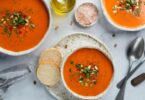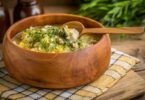Cooking techniques are the methods and skills you use to transform raw ingredients into edible dishes. Cooking techniques can affect your food’s flavor, texture, appearance, and nutritional value. Some cooking techniques, such as boiling, baking, grilling, or frying, are simple and easy. Others are more complex and require special equipment, such as sous vide, smoking, or molecular gastronomy. Learning different cooking techniques can expand your culinary repertoire and allow you to create more diverse and creative dishes.
Basic Cooking Techniques
Basic cooking techniques are the ones that you use most often in your everyday cooking. They are usually straightforward but can produce amazing results if you master them. Here are some of the most common basic cooking techniques and how to use them:
- Boiling: Boiling is the process of cooking food in a liquid at or near its boiling point, usually water. Boiling is suitable for cooking tender foods that need to be softened, such as pasta, rice, potatoes, eggs, or vegetables. To boil food, you need to fill a pot with enough water to cover it, bring it to a boil, add salt or other seasonings if desired, and then add the food. You can adjust the heat to maintain a gentle boil and cook the food until it is done, according to the recipe or your preference. You can also use a lid to speed up the cooking process or reduce evaporation. Boiling is a fast and easy way to cook food, but it can also cause some nutrients to leach out into the water, so you may want to save the cooking liquid for soups or sauces.

- Baking: Baking is the process of cooking food in an oven using dry heat. Baking is suitable for cooking foods that are firm or need to be browned, such as bread, cakes, cookies, pies, casseroles, or meat. To bake food, preheat the oven to the desired temperature, prepare the food according to the recipe, and place it in a baking dish or on a baking sheet. To prevent sticking, you can also grease or line the baking dish or sheet with parchment paper or foil. You can also use a thermometer to check the doneness of the food, especially for meat or poultry. Baking is a versatile and convenient way to cook food, but it can also dry out the food or cause it to burn if you are not careful.

- Frying: Frying is the process of cooking food in hot oil or fat over high heat. Frying is suitable for cooking crispy foods that need to be cooked quickly, such as chicken, fish, french fries, or pancakes. To fry food, heat oil or fat in a skillet or a deep-fryer to the desired temperature, usually between 350°F and 375°F. You can use a thermometer or a small piece of bread to test the temperature of the oil. You can also coat the food with flour, breadcrumbs, or batter to create a crunchy crust. You can then carefully lower the food into the hot oil and fry it until it is golden and cooked, turning it occasionally. You can also use a slotted spoon or a spider to remove the food from the oil and drain it on paper towels or a wire rack. Frying is a quick and tasty way to cook food, but it can also add a lot of calories and fat to your diet, so you may want to limit your intake or use healthier oils, such as olive or canola oil.

- Sautéing : Sautéing is another basic cooking technique that you can use to cook food quickly and evenly. Sautéing is the process of cooking food in a small amount of oil or fat over high heat, stirring or tossing it frequently. Sautéing is suitable for cooking foods that are thin, small, or tender, such as chicken, shrimp, mushrooms, or onions. To sauté food, you need to heat oil or fat in a skillet over high heat until it is hot but not smoking. You can also add aromatics, such as garlic, ginger, or herbs, to the oil or fat for extra flavor. You then need to add the food in a single layer and cook it until it is browned and cooked through, stirring or tossing it occasionally. You can also deglaze the skillet with wine, broth, or juice to create a sauce. Sautéing is a fast and easy way to cook food, but it can also splatter or burn if you are not careful.

- Grilling: Grilling is another basic cooking technique that you can use to cook food with direct heat from a fire, coals, or gas. Grilling is suitable for cooking foods that are firm, thick, or need to be charred, such as meat, poultry, fish, or vegetables. To grill food, you need to preheat the grill to the desired temperature, usually between 400°F and 500°F, depending on the food and your preference. You can also oil the grill grates to prevent sticking. You then need to season the food according to the recipe and place it on the grill. You need to flip the food once or twice and cook it until it is done, according to the recipe or your preference. You can also use a thermometer to check the doneness of the food, especially for meat or poultry. You can also brush the food with sauces, glazes, or marinades during the last few minutes of grilling to add more flavor. Grilling is a fun and flavorful way to cook food, but it can also cause flare-ups or smoke if you are not careful.

Advanced Cooking Techniques
Advanced cooking techniques are the ones that require more skill, equipment, or time to execute. They are usually more challenging and complex but can produce more impressive and delicious results. Here are some of the most popular advanced cooking techniques and how to use them:
- Sous vide : Sous vide is the process of cooking food in a vacuum-sealed bag immersed in a water bath at a precise and constant temperature. Sous vide is suitable for cooking foods that need to be cooked evenly and tenderly, such as steak, chicken, fish, or vegetables. To sous vide food, you need to season the food and seal it in a plastic bag, either with a vacuum sealer or a water displacement method. Add herbs, spices, or marinades to the bag for extra flavor. You then need to set the water bath to the desired temperature, usually between 120°F and 160°F, depending on the food and your preference. You can use a sous vide machine or a pot with a thermometer and a circulator to maintain the temperature. You then need to submerge the bag in the water and cook the food for the required time, ranging from 30 minutes to 72 hours, depending on the food and the doneness. You can also finish the food by searing it on a skillet or a grill to create a crust. Sous vide is a precise and consistent way to cook food, but it can also be expensive and time-consuming.

- Smoking: Smoking is the process of cooking food by exposing it to smoke from burning wood, charcoal, or other materials. Smoking is suitable for cooking foods that must be simmered and imparted with a smoky flavor, such as meat, poultry, fish, cheese, or nuts. To smoke food, you must prepare it according to the recipe, usually by curing, brining, or seasoning it. Depending on the flavor and intensity you want, you need to choose the type of wood or fuel you want to use, such as hickory, apple, or mesquite. Adding herbs, spices, or liquids to the wood or fuel for extra flavor. You must then set up the smoker with a dedicated smoker or a grill with a smoker box or a foil pouch. It would help if you preheated the smoker to the desired temperature, usually between 200°F and 300°F, depending on the food and your preference. You must place the food on the smoker rack and close the lid. You need to monitor the temperature and smoke level, adjust the vents, or add more wood or fuel as required. You also need to check the doneness of the food, either with a thermometer or a visual cue, such as the color or the texture. Smoking is a flavorful and aromatic way to cook food but it can also be messy and tedious.

- Molecular gastronomy : Molecular gastronomy is the process of cooking food by applying scientific principles and techniques, such as chemistry, physics, or biology. Molecular gastronomy is suitable for creating foods with unusual shapes, textures, colors, or flavors, such as spheres, foams, gels, or powders. You must use unique ingredients and equipment to practice molecular gastronomy, such as hydrocolloids, enzymes, syringes, or blowtorches. You must also follow specific recipes and instructions, as molecular gastronomy can be precise and delicate. Some examples of molecular gastronomy dishes are spherified olives, carbonated fruit, or bacon ice cream. Molecular gastronomy is a creative and innovative way to cook food, but it can also be complicated and expensive.

Remember, cooking is an art that requires practice, so don’t be discouraged if you don’t become a master chef overnight. Start with these low-difficulty cooking techniques, and as you gain confidence and experience, you can explore more advanced methods. With time and dedication, you’ll be creating delicious homemade meals that will impress your family and friends. Happy cooking!







